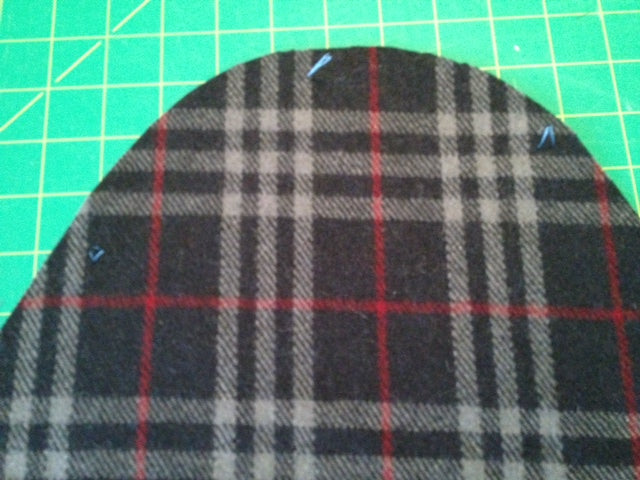Sew Along: Winter Coat Update: Sewing the Good Fabric

Last weekend I made a big dent in the progress of my Burberry-inspired winter coat. There is not a lot to report back on, but I will highlight a few little things that I did to enhance the coat.
- Did you ever use tailor's tacks? I'm sure many of you know this little trick, but I felt the need to share it in case some of you don't know about it! My mother taught me how to use these and they are one of the best ways to mark your fabric. I don't care for using chalk marks because it always seems like they disappear by the time I get to that section of a garment.
Thread a needle with a contrasting thread. Make sure to meet the ends of the thread. This is a good time to use threads that you hardly use, or old threads that may be too brittle to use in your sewing machine. (I have some of these inherited from my grandmother.) Then poke the needle through the pattern paper and all layers (good fabric, lining, etc.) leaving about 6-7 inches on the top of your stack. Then poke the needle up through stack and pull the needle through. Make sure you have two tails of 6-7 inches. Pull off the pattern paper. Starting at the bottom of your stack, pull apart each section leaving an even amount of thread between the sections. Cut the threads so that you have a tack attached to each piece. (If you leave your threads a little longer, you could even tie the threads in a loose knot to prevent them from falling out.) Now all your pieces are marked! It takes a little longer, but I feel is worth it.
- While fusing interfacing on all the necessary pieces, I fused a 3" piece of lightweight fusible interfacing and placed it along the bottom edge of the hem and hem on your sleeves. This creates a crisp hem when you press the hem up rather than a "baloon-like" hem. I will take a picture of the finished hems when the coat is finished. Here is a picture of the interfacing along the hem of the sleeve.
- I decided to add flannel to the inside of my coat to make it even warmer. Rather than basting it all in place, I used 505 Spray and Fix by Odif USA. I use it all the time for holding pieces together. It is temporary, but fairly strong and does not ruin your fabric. It also does not gum up your needle which is a HUGE plus for me. After it was attached I cut approximately 1/2 inch from all edges of the flannel to reduce the bulkiness in the seams.
Here is a picture of a section I was VERY happy when all the plaids matched. At this point I was matching the side seams and creating the pockets.
Next post I'm hoping to share with you more interesting things! I should have the entire coat constructed at that point. Happy Holidays!
~ Julie
-
|
Posted on December 27 2012





it is really fun to watch your progress. Looking great!
I'm curious about this 606 Spray and Fix. Where do you usually get yours? Does a can generally last long – or do you have to lather on the spray to get any results? One more thing — do you use a particular interfacing for the hems?
’@Pegsewer- Thanks! I am soooo close to being finished at this very moment. I can't wait to share!
@Jenny – I use the 505 Spray and Fix. There are a few "number" sprays from the brand. I've actually gotten it at a local quilt shop in our area, but I think I've seen it at Joann Fabrics. I don't lather on the spray, it seems to hold fairly well by just a wisk of the can over the fabric. As for the interfacing—-I used a fusible weft interfacing as the interfacing on the hem. I would say that any light-medium weight fusible interfacing would be fine.
Leave a comment
All blog comments are checked prior to publishing